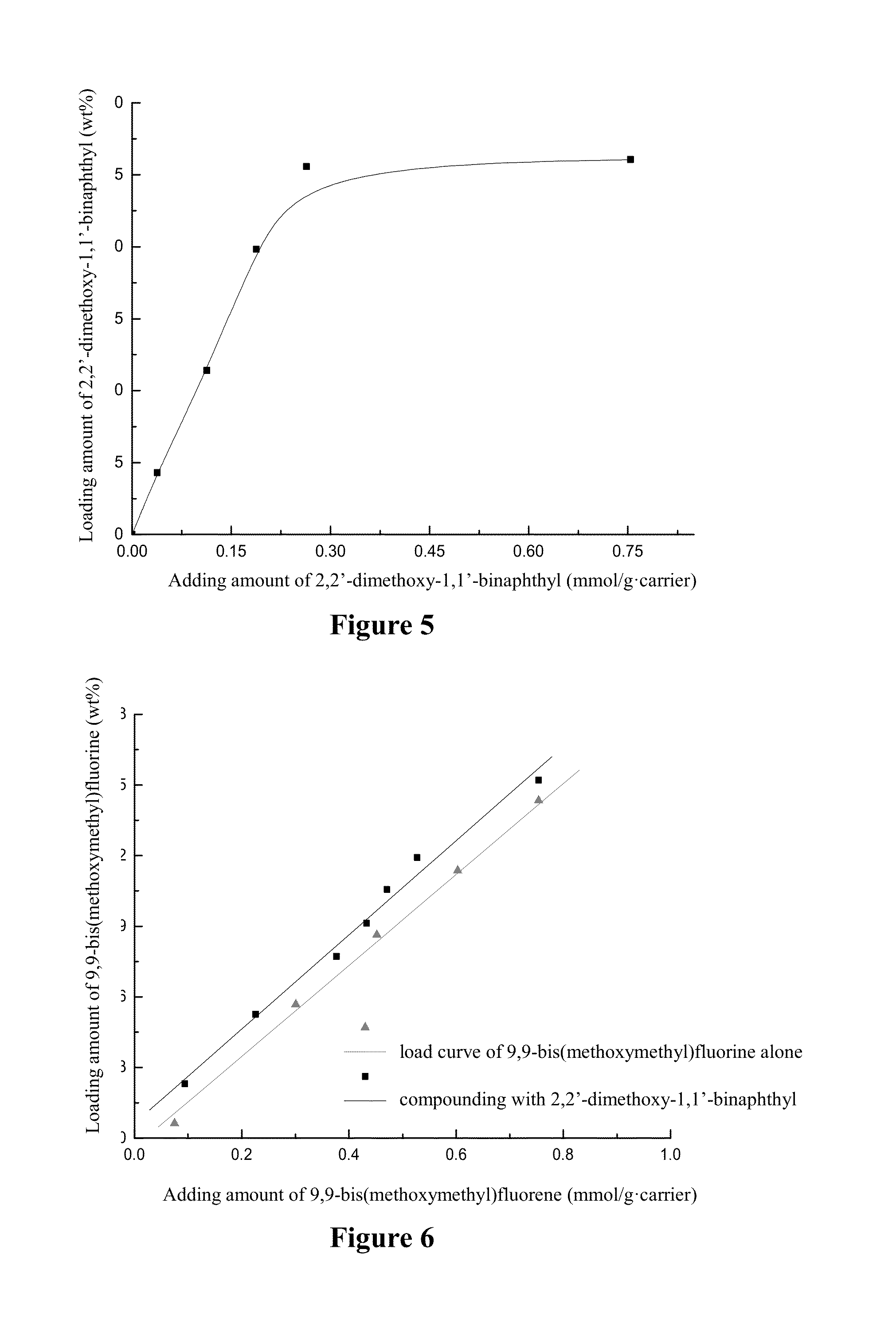Internal Electron Donor Compound for Preparing Alpha-olefin Polymerization Catalyst Component
a technology of alpha-olefin and catalyst, which is applied in the preparation of organic compounds, chemistry apparatus and processes, and chemical instruments and processes, etc., can solve the problems of limited performance, inability to meet the growing demand of the polyolefin industry, and difficult development of a practical internal electron donor, so as to save the cost of internal electron donors and improve the efficiency of the process , the effect of reducing the blindness of experiments
- Summary
- Abstract
- Description
- Claims
- Application Information
AI Technical Summary
Benefits of technology
Problems solved by technology
Method used
Image
Examples
embodiment 1
Preparation of Catalyst Component with a Single Internal Electron Donor
Using Internal Electron Donor of 9,9-Bis(Methoxymethyl)Fluorene as an Example
[0064]Prepare series of catalyst components by 9,9-bis(methoxymethyl)fluorene as internal electron donor, the adding amounts of 9,9-bis(methoxymethyl)fluorine are 0.08, 0.30, 0.45, 0.60, 0.75, 0.86, and 1.10 mmol / g·carrier respectively. Determine the loading amounts of 9,9-bis(methoxymethyl)fluorene in the catalyst components, which are 1%, 6%, 9%, 11.5%, 14.5%, 17.5%, and 17.6% respectively, and make the adding-loading amount load curves.
[0065]Carry out the operations same as the above preparation steps and prepare the catalyst components by dibutyl phthalate, diisobutyl phthalate, 2,3-diisopropyl dibutyl succinate, and 2,2′-dimethoxy-1,1′-binaphthyl as the internal electron donors respectively. Determine the loading amounts of internal electron donors in the catalyst components, and make the adding-loading amount load curves respective...
embodiment 2
Preparation of Propylene Polymerization Catalyst Component of Two Kinds of Internal Electron Donors
[0067]Compounding 9,9-bis(methoxymethyl)fluorene with dibutyl phthalate as an example.
[0068]When preparing catalyst component, the sum of the loading amounts of two kinds of electron donors are controlled within the range of 8%-16% according to FIG. 3. When heating the reaction mixture to 70° C., simultaneously add 9,9-bis(methoxymethyl)fluorene and dibutyl phthalate dissolved in toluene into the reaction mixture to prepare series of compound catalyst components, and determine their respective adding-loading amount competition load curve.
[0069]The above method is also applicable to the preparation of two kinds of internal electron donor catalyst components by the combinations of 9,9-bis(methoxymethyl)fluorene and diisobutyl phthalate, 9,9-bis(methoxymethyl)fluorene and 2,3-diisopropyl dibutyl succinate, 9,9-bis(methoxymethyl)fluorene and 2,2′-dimethoxy-1,1′-binaphthyl, dibutyl phthalat...
embodiment 3
Prepare catalyst component by the compound of 9,9-bis(methoxymethyl)fluorene (A) and 2,2′-dimethoxy-1,1′-binaphthyl (B) as internal electron donor
[0071]FIG. 4 shows the load curve of 9,9-bis(methoxymethyl)fluorene; FIG. 5 shows the load curve of 2,2′-dimethoxy-1,1′-binaphthyl; FIG. 6 shows the load curve of 9,9-bis(methoxymethyl)fluorene and its compound competition load curve with 2,2′-dimethoxy-1,1′-binaphthyl; FIG. 7 shows the load curve of 2,2′-dimethoxy-1,1′-binaphthyl and its compound competition load curve with 9,9-bis(methoxymethyl)fluorene;
[0072]Take values from the respective compound competition load curve of 9,9-bis(methoxymethyl)fluorene and 2,2′-dimethoxy-1,1′-binaphthyl obtained in embodiment 2 as the expected load values. According to the experiment results of embodiments 1 and 2, 9,9-bis(methoxymethyl)fluorene has a stronger competitive capacity, and its maximum loading amount is about 16%, thus control the total expected loading amount at 7%-16%. Prepare compound c...
PUM
| Property | Measurement | Unit |
|---|---|---|
| temperature | aaaaa | aaaaa |
| temperature | aaaaa | aaaaa |
| temperature | aaaaa | aaaaa |
Abstract
Description
Claims
Application Information
 Login to View More
Login to View More - R&D
- Intellectual Property
- Life Sciences
- Materials
- Tech Scout
- Unparalleled Data Quality
- Higher Quality Content
- 60% Fewer Hallucinations
Browse by: Latest US Patents, China's latest patents, Technical Efficacy Thesaurus, Application Domain, Technology Topic, Popular Technical Reports.
© 2025 PatSnap. All rights reserved.Legal|Privacy policy|Modern Slavery Act Transparency Statement|Sitemap|About US| Contact US: help@patsnap.com



